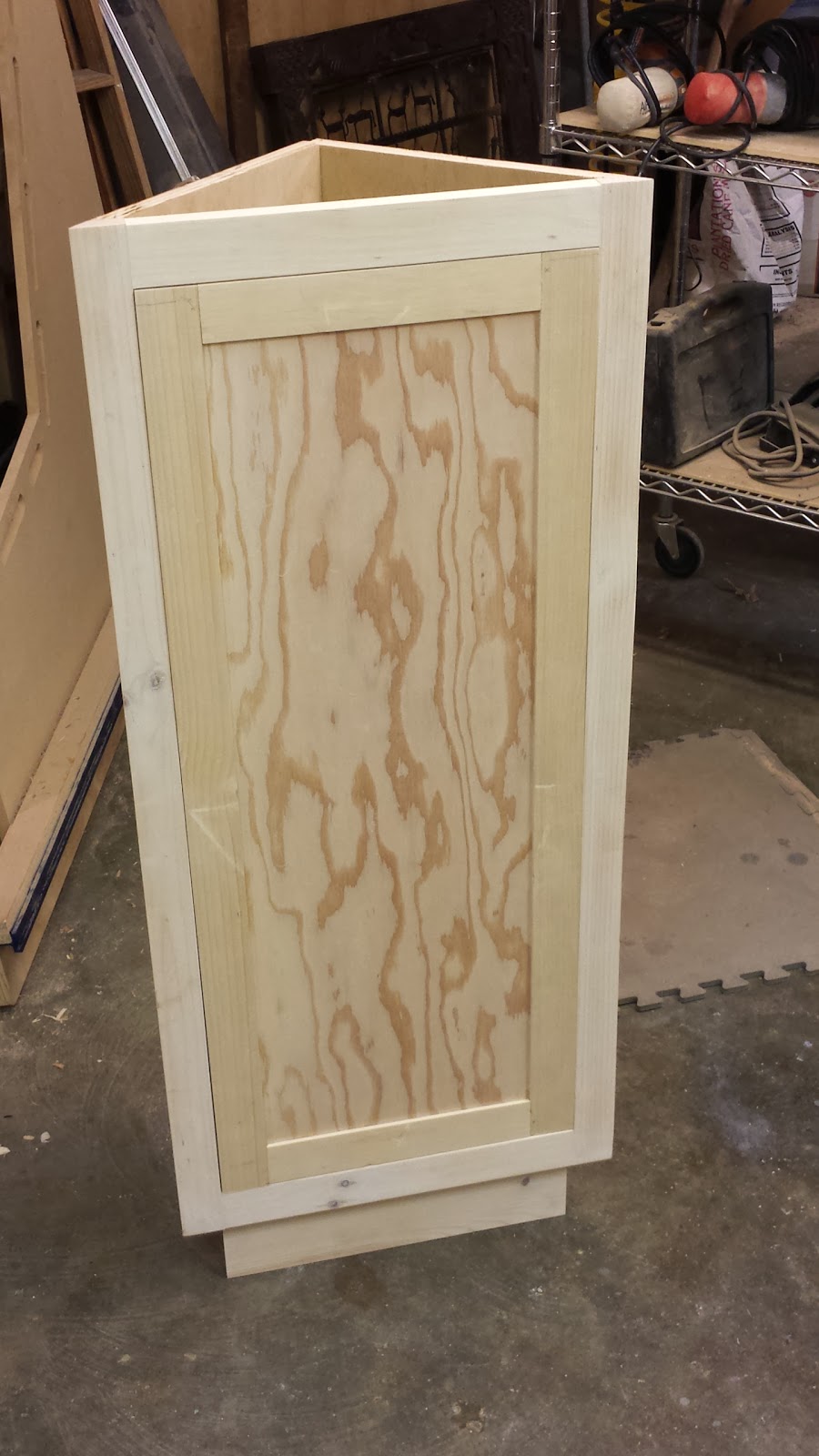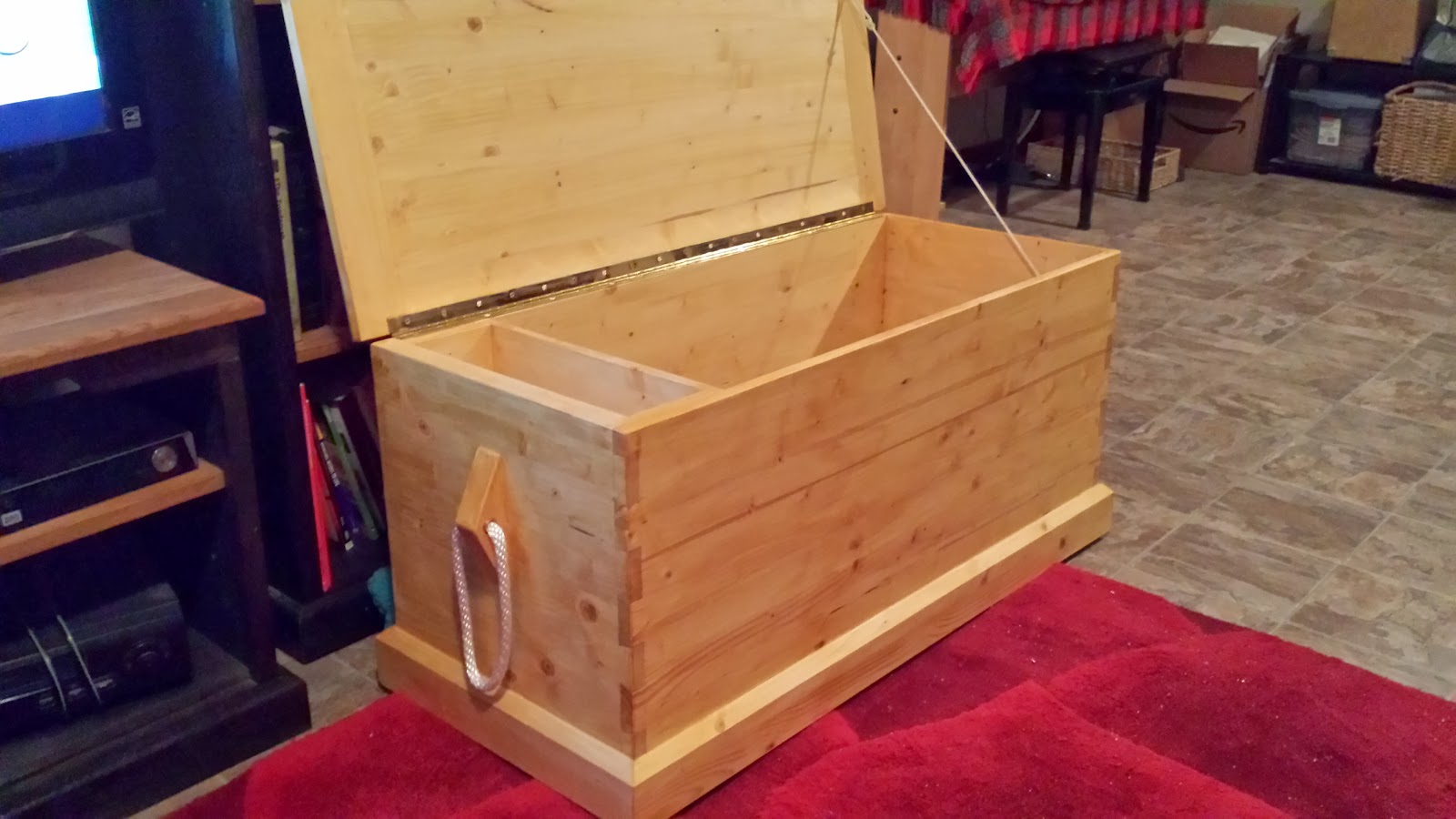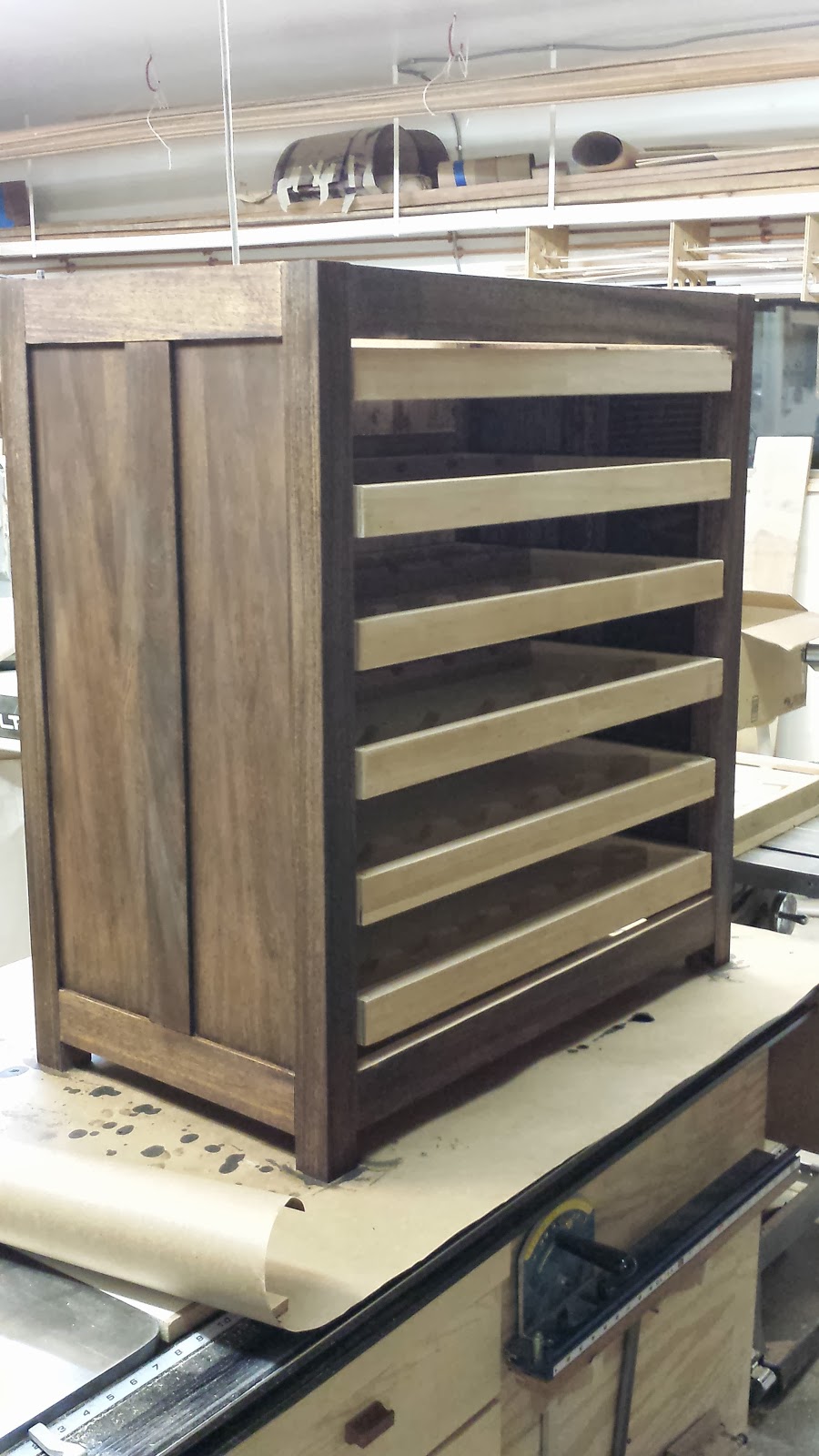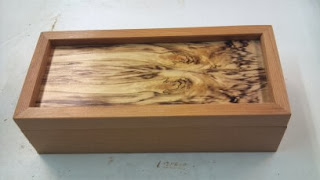This dry fit of the door shows the project almost complete...just need a lid and some white paint.
Alaska Wood
Blogging for JRG Designs/Chester Creek Woodworks -Custom Furniture in Anchorage. See http://chestercreekwoodworks.com
Sunday, January 26, 2014
Bathroom Corner Cabinet
My customer, a wee Scottish lass, desires a small cabinet to house her rolls of tissue in the corner of bathroom. It is to be painted, so I'll just use some Pine and plywood. All the frame and door joints are mortise and tenon.
This dry fit of the door shows the project almost complete...just need a lid and some white paint.
This dry fit of the door shows the project almost complete...just need a lid and some white paint.
Monday, January 20, 2014
How to cut dovetails
Let's take a pine seachest for a working demonstration of how to cut dovetails.
You will need a marking gauge, sliding T bevel, a fine tooth saw (carcass saw/DT saw/tenon saw), chisels, mallet, coping saw or bandsaw.
1. Starting with the tail board, lay out the thickness of your connecting board (plus about 1/32) with the marking gauge on both sides of your board. you can use a pencil line, but I like to scribe with a sharp blade in my gauge.
2. Lay out the tails however you like...you can calculate exact dimensions, make them different size and spacing or just do them free hand. It only matters what function and appearance you are interested in. Don't make the tail angle too wide...too much and you run the risk of a weak tail.
However, the important part is to cut them square on the edge. You won't notice if the angle of the tail is a little off, but the edge must be square or there will be a gap in the finished product.
Mark the waste with an X on both faces and the edge...you will thank me.
3. Use a square to carry the lines over the edge. This is your most important guide line for the saw.
4. Cutting on the waste side of your line, saw to the scribed mark. This isn't crucial on the tails but gives you practice, so you can do a flawless job on the pins. Remember, the important part is making the edge cut square to the face.
 |
| edge cut perfect |
5. OK, now you have to get rid of the waste. In this example, I use my bandsaw to remove right to the line since this project in pine allows for a little slop. You might want to saw just in front of the line and clean up with a chisel if you're looking for perfection. Again, cut on the waste side of the line.

6. Once you have the waste cleaned out, it's time to mark the pins. Mount your pin board in the vise and lay the tail board on it. Stick something under the board to hold it level while you mark. This board is 16 inches, so I could hold it with my left hand while marking. You might want to clamp it with smaller stuff.
I use a marking knife, but a sharp pencil might be fine also. It is just important to make an accurate transfer of the tail to the edge of pin board...all highly visible in finished product. Drop the lines down to scribe line with a square.and mark the waste sections with an X again. Nothing more frustrating than going to all that work to cut on the wrong side of the line and leave a gap in the joint. A repairable problem, but a pain in the bum.
8. Remove the waste again...if you don't have a bandsaw, a coping saw works fine also. Now you are ready to fine-fit the joint. Work only on the pin board, unless there is some obvious need to fix something on the tail board. If you start cutting on both boards, you will end up with a disaster. Be patient, check the fit, mark where you need to trim and take just a little at a time.
9. Dry fit the whole thing and make adjustments as necessary then glue up. Notice the many glue surfaces...best to use a small flux brush to spread it. Clamp it both directions, of course.
After a couple coats of amber shellac, the job looks good. All hands aboard!
Wednesday, December 18, 2013
Rocker Repair
A gentleman asked me at the Arts and Crafts show if I would consider repairing a rocker that belonged to his grandmother, but has broken down and just sits in the garage awaiting the wood doctor.
When he brought over the heirloom, it was indeed in very bad shape...all the joints were loose or broken with the three of the legs split at the mortice. Nails were everywhere, and it was constructed in such a manner that to re-upholster, one must disassemble the rocker. Not a good design. But we carry on ;o)
Here are the initial pictures I took.

Front right leg is broken away from side tenon carrying a large piece off the leg surrounding mortice.
How it looks after I got the chair disassembled and all the nails pulled -- there were two brads through every tenon (grrr).
Routed out the damaged area on leg to accept new wood..
All done and ready for the new baby!
When he brought over the heirloom, it was indeed in very bad shape...all the joints were loose or broken with the three of the legs split at the mortice. Nails were everywhere, and it was constructed in such a manner that to re-upholster, one must disassemble the rocker. Not a good design. But we carry on ;o)
Here are the initial pictures I took.

Front right leg is broken away from side tenon carrying a large piece off the leg surrounding mortice.
How it looks after I got the chair disassembled and all the nails pulled -- there were two brads through every tenon (grrr).
Routed out the damaged area on leg to accept new wood..
All done and ready for the new baby!
Thursday, December 5, 2013
Wine Bar
My customer has windows from India via an antique shop in Kuwait ;o) He wants a wine bar with a granite top. Here is the basic material I have to work with: I'll be posting progress. Will build a cabinet to house the wine, install a granite top with LED strip that is motion activated to illuminate wine when doors are opened.
12/20...Still waiting for a new arbor for my Unisaw...so I can't mill the Mahogany for cabinet...just have to work on routing recess for mirror and glass.
Glass and mirror are cut and ready to use.
... the Unisaw is finally repaired, running smoothly again. All the lumber milled to size, mortices and tenons cut and routed grooves for panels. Pressed up some veneer panels and voila...we almost have a cabinet...looking at the back/side.
I glued up the end sections first, so I could attach drawer glides with ease...then did the final connection with front and back sections.
After the drawers were completed and installed then outside stained dark.
I had to do some cleaning of the old window frame carving before touch up staining and sprayed a little shellac to brighten them up a bit.
I also got the motion sensor and LED strip light wiring all installed. As soon as granite is ready, I can put things together.
3/31/14 Customer and I finally got our schedules together and I delivered today. He was thrilled that a ten year dream was fulfilled.
| These will be used a doors to access the wine. Glass panels will be installed on the back of them. |
| This will be on top of bar with a mirror installed behind. All that iron work is pretty interesting. |
Glass and mirror are cut and ready to use.
... the Unisaw is finally repaired, running smoothly again. All the lumber milled to size, mortices and tenons cut and routed grooves for panels. Pressed up some veneer panels and voila...we almost have a cabinet...looking at the back/side.
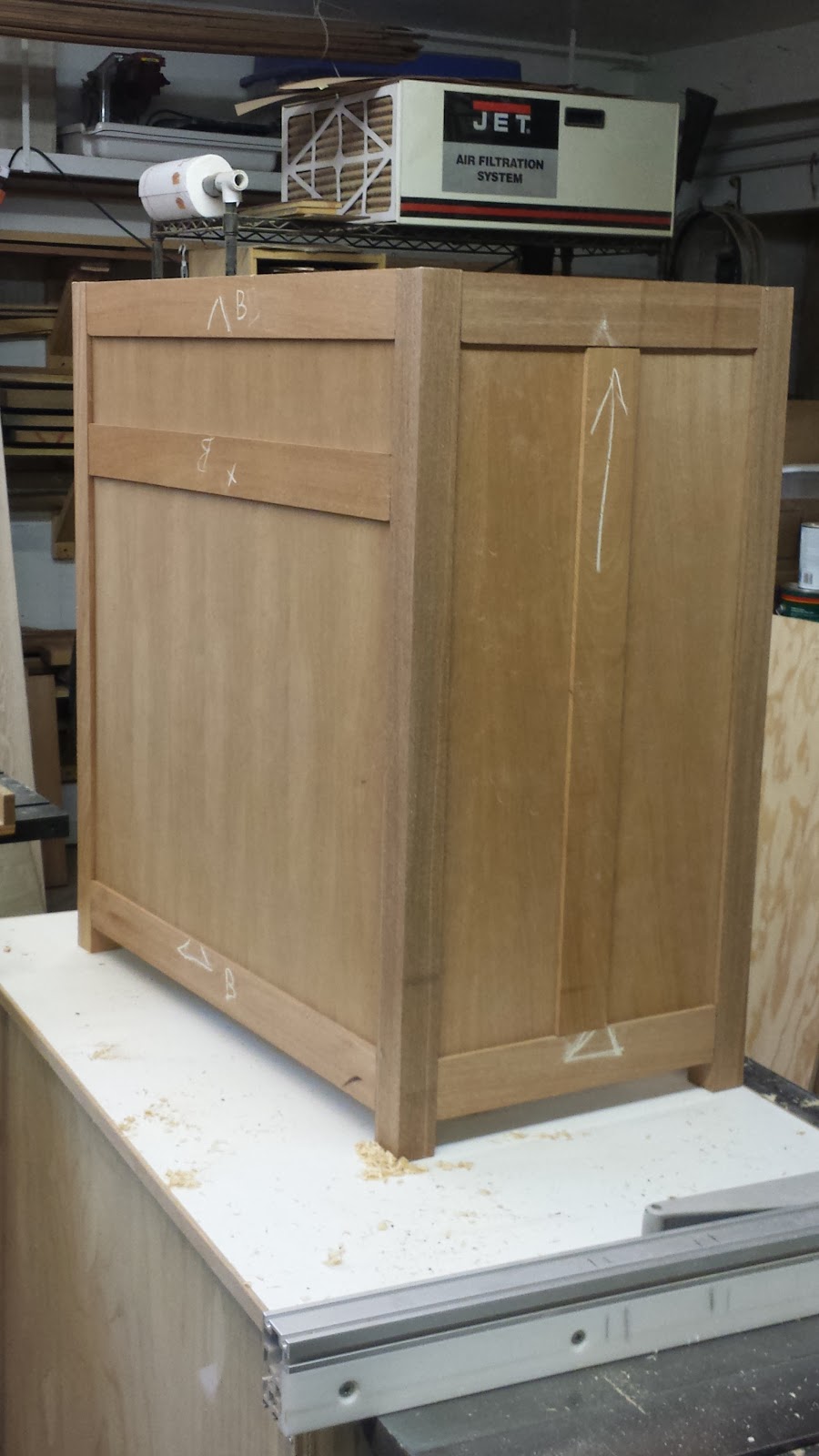 |
| Dry fit...no glue yet! |
After the drawers were completed and installed then outside stained dark.
I had to do some cleaning of the old window frame carving before touch up staining and sprayed a little shellac to brighten them up a bit.
I also got the motion sensor and LED strip light wiring all installed. As soon as granite is ready, I can put things together.
3/31/14 Customer and I finally got our schedules together and I delivered today. He was thrilled that a ten year dream was fulfilled.
Tuesday, November 12, 2013
Hardwood Cutting Boards
Wood cutting boards are superior to plastic or glass panels for a number of reasons.
1.Wood is naturally resistant or even hostile to microbial growth, unlike plastic which harbors bugs in scratches.
2. Wood is pleasing to look at and warm to the touch.
3. Wood is easy on your good knives. Glass will dull the blade quickly
4. Wood will last decades with care, while plastic will just get scratched up and glass will break eventually.
My boards are all unique and beautiful. Each is sanded to 220 and finished with bee's wax. Raymond the pig received an upgrade this year -- a eye made of Walnut and Vermillion. He is very happy.
We have about three dozen boards for this year's show.
 |
| Traditional styles |
 |
| Gorgeous laminations of Maple, Vermillion, Black Walnut and Cherry |
Maple Two Stepper
I made four two steppers out of "natural" Maple. I found some nicely colored boards at the lumber yard and made these a little shorter than I normally do after consulting with my design expert (Mrs. Alaska Wood). A new change in the design is using cutout from the bottom as a gusset stiffener in the back.
At 16 inches, the top step is more than adequate for kitchen use. The one shown here is actually a little smaller -- for smaller folks (or ones who get airsick).
At 16 inches, the top step is more than adequate for kitchen use. The one shown here is actually a little smaller -- for smaller folks (or ones who get airsick).
 |
Small items for Holiday Show
Whistles from hardwood scraps.
My wife grabbed one right away and began using it to
call the dogs. In the interest of time, I made them all the same pitch ( same length sound chamber ), but different sounds are easy to make just by drilling the chamber deeper.
 Jacob's Ladder Toy
Jacob's Ladder Toy
Always a pleaser to the young. Some old toys are unbeatable.
Wood bolts with washers and nuts. 1.5 inches diameter
I began using the big threading set to make actual vises for workbenches when I had thoughts of teaching shop class to kids. Unfortunately, the liability issue is too much for me....sad for kids. But I found making bolts with matching nuts and washers are fascinating to play with, and teaches how screws work.
My wife grabbed one right away and began using it to
call the dogs. In the interest of time, I made them all the same pitch ( same length sound chamber ), but different sounds are easy to make just by drilling the chamber deeper.
 Jacob's Ladder Toy
Jacob's Ladder ToyAlways a pleaser to the young. Some old toys are unbeatable.
Wood bolts with washers and nuts. 1.5 inches diameter
I began using the big threading set to make actual vises for workbenches when I had thoughts of teaching shop class to kids. Unfortunately, the liability issue is too much for me....sad for kids. But I found making bolts with matching nuts and washers are fascinating to play with, and teaches how screws work.
Nature's Art Salvaged From The Woodpile
These panels are destined for the top panel in several boxes. I resaw partially rotted Birch logs and dry them for 6 months to a year before planning or thickness sanding. I then put clean edges on them and glue up book-matched pieces.
Another round of sanding to 220 grit and then shellac several coats. I love the symmetry achieved by book-matching and often enjoy seeing recognizable shapes emerge. Maybe I could market them to a shrink for "natural" Rorschach image.
Five Douglas Fir boxes with Walnut keys all ready for sawing their tops off.
I got more mileage out of the Doug Fir and made 1/4 x 1 inch lattice to improve the storage possibilities of the boxes, and a little sliding tray to hold longer things...pencils, brushes and the like.
This is a mahogany box, not hinged yet, but showing what a beautiful addition the material is.
I also sawed up a spruce burl I have had for about 10 years. It went through the same process with interesting results. When finished the grain looks 3-D, changing with how the light hits it.
Another round of sanding to 220 grit and then shellac several coats. I love the symmetry achieved by book-matching and often enjoy seeing recognizable shapes emerge. Maybe I could market them to a shrink for "natural" Rorschach image.
Five Douglas Fir boxes with Walnut keys all ready for sawing their tops off.
I got more mileage out of the Doug Fir and made 1/4 x 1 inch lattice to improve the storage possibilities of the boxes, and a little sliding tray to hold longer things...pencils, brushes and the like.
This is a mahogany box, not hinged yet, but showing what a beautiful addition the material is.
I also sawed up a spruce burl I have had for about 10 years. It went through the same process with interesting results. When finished the grain looks 3-D, changing with how the light hits it.
Toddler workbench
In preparation for the holiday show, I added a small "workbench" for toddlers. I remember pounding on wood dowels on a similar one when I was a bit shorter ;o)
Each bench has a 1 1/2 inch threaded bolt for extra stimulation and are finished with shellac. Shellac is non-toxic and actually edible--that's what puts the shine on your coated tablets from the pharmacy ;o).
Each bench has a 1 1/2 inch threaded bolt for extra stimulation and are finished with shellac. Shellac is non-toxic and actually edible--that's what puts the shine on your coated tablets from the pharmacy ;o).
Child's Mission Rocker in Oak
I built a couple of small rockers for the Arts and Crafts Emporium Show in November. Folks seem to like something for the kids that is going to last until they have their own kids.
These two are quarter sawn White Oak, constructed with blind and through tenons. Traditional methods, timeless appeal.
This year's model has a larger seat so it can be used for a few more years.
Salvaged Douglas Fir
We replaced the front door on our house, and I kept the old wood door for possible recovery of useable wood. To my surprise, the stiles and rails were beautiful, quarter-sawn, clear DF -- some of which was from very old trees. Look at the minute grain separation. I resawed the rails to 3/8 inch stock for making boxes. the hinge stile and bottom rail I am saving to make a small cabinet.
And this is one of the finished boxes which sports a spalted Birch panel in the top. I like the contrast of the DF and wild grain or figure in the panels.
I added 1/4 inch lattice to these boxes to make them more useful for storing small stuff...and my partner put leather in the bottom.
And this is one of the finished boxes which sports a spalted Birch panel in the top. I like the contrast of the DF and wild grain or figure in the panels.
I added 1/4 inch lattice to these boxes to make them more useful for storing small stuff...and my partner put leather in the bottom.
Subscribe to:
Posts (Atom)
